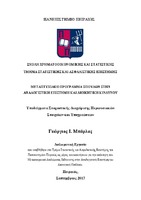Υποδείγματα στοχαστικής διαχείρισης περιουσιακών στοιχείων και υποχρεώσεων
Models of stochastic asset and liability management

View/
Keywords
Asset and liability management ; Γραμμικός προγραμματισμός ; Χρηματαγορά ; Περιουσιακά στοιχείαAbstract
In the present diploma thesis initially are examined the distinctions between strategic and static techniques currently used in asset-liability management. In addition, the strategies are categorized into dynamic, based on the principles of immunization and driven by value, and those driven mainly by return.
Examples of value-driven strategies / techniques are standard immunization and key rate immunization, but there are various kinds of such strategies in general, each with its advantages and disadvantages.
It is also examined the risk-return approach, based on the theoretical achievements of previous decades and on the assumption that when two portfolios have different returns, either have a different level of risk or either is ineffective.
The various asset and liability management techniques and strategies are developed in order to make the particularities, as well as the more apparent negative and positive characteristics that each of them may have.
The study uses short-term liabilities to finance long-term assets, with similar results as in the case of Fannie Mae.
Additionally, the use of linear programming is sought to find an optimal mix of financial products to meet the needs of short-term corporate finance.
Finally, we try to answer the question: "Can stocks help mend the asset and liability mismatch?"


